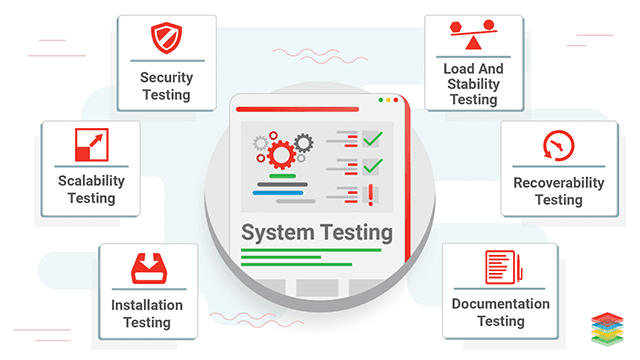
What is System Testing?
System testing of software or hardware conducted on an entire, integrated system to assess the system's compliance with its specified requirements. It carried out by testers. This testing also examines both functional and nonfunctional requirements of the testing. It is the process of testing an integrated system to verify that it meets specified requirements. It is the level of software testing performed before Acceptance Testing and after Integration Testing. It comes under Black Box testing, i.e., only external working features of the software evaluated during this testing. It doesn't require any internal knowledge of the coding, programming, design, etc., and completely based on users-perspective.
Enabling best Software Testing practices changes the way of integrating testing into the development process. Source - Software Testing Best Practices
What are the types of System Testing?
There are various the types of System Testing are listed below:
-
Functionality Testing - Also known as functional completeness testing. To ensure that the functionality of the product working as per the requirements defined, within the capabilities of the system.
-
Recoverability Testing - To ensure how well the system recovers from various input errors and other failure situations. Recovery testing done to show a software solution is reliable, trustworthy and successfully recover from possible crashes.
-
Interoperability Testing - To ensure whether the system works well with third-party products or not.
-
Performance Testing - To make sure the system’s performance under the various condition, regarding performance characteristics.
-
Regression Testing - To make sure the system’s stability as it passes through the integration of different subsystems and maintenance tasks. It also makes sure no old bugs appear from the addition of new software modules over time.
-
Usability Testing - To make sure the user's ease to use the application, flexibility in handling controls and the ability of the system to meet its objectives.
-
Migration Testing - Migration testing done to ensure that the software moved from old system infrastructures to current system infrastructures without any issues.
Some more types are below:
-
Scalability Testing
-
Reliability Testing
-
Documentation Testing
-
Security Testing
-
Exception Handling
-
Volume Testing
-
Stress Testing
-
Sanity Testing
-
Smoke Testing
-
Exploratory Testing
-
Ad-hoc Testing
-
Installation Testing
-
Maintenance of Testing
A process to check that deployed build is stable or not. It helps a QA team to get confirmation QA team can proceed for further testing or not. Click to explore about, Smoke Testing Best Practices
How it works?
The working steps of System Testing are described below:
Create Test Plan
To test the system completely, the initial step is to define the expectations of the test cases. Also, understand the system’s Real-Time usage. The system Test plan may vary from organization to organization as well as based on the project plan, test strategy & main test plan. Standard points considered while creating the Test Plan -
-
Goals & Objective
-
Scope
-
Critical areas Area to focus
-
Test Deliverable
-
Testing Strategy
-
Testing Schedule
-
Entry and exit criteria
-
Suspension & resumption criteria for system testing
-
Test Environment
-
Roles and Responsibilities
Create Test Cases
Creating a different type of test cases, such as functional, regression, load, GUI, scalability, installation, etc., is the next step. Test cases must cover all functional, non-functional, technical, and user-interface requirements. It is very much related functional test case writing. In the test case writing, write the test scenarios and use cases.
Sample Test Case Format
| Test Case ID | Test Suite Name | How to Test? | Test Data | Expected Result | Actual Result | Pass/Fail |
Create Test Data
Once test cases developed, determine or create the required test data to perform a critical job in test execution. These are the inputs that assist the team to get expected results.
Test Case Execution
Finally, the test cases made earlier executed by the team, who continually monitor the process and record any errors or issues found by them during the process. Additionally, the output of the testing also recorded.
Bug Reporting & Fixation
Report all the recorded bugs and issues to the concerned individual of the team. When revealed, fix as well as resolve the issue. Repeat the Cycle (If Required) - After all the bugs and issues resolved and fixed, the team rehashes the test cycle to get the expected outcomes.
What are the benefits?
The benefits of system testing are listed below:
-
It covers end to end testing.
-
Proper Testing help in easing after production goes live issues and bugs.
-
System tests run naturally (for example, every night) so that testing is done as the application developer.
-
Business requirements and software architecture are tested.
-
The application tested thoroughly after each iteration and sprint. Hence, there are lesser probabilities of failure and risks later on.
-
System tests help to test that the application working correctly from a user.
-
System tests help specify how the application should behave.
This directed in an environment similar to a production environment, or some of the times it is done with prod parallel test environment where same data fed to the existing system and a new system to compare the distinctions in functionalities included and removed. This causes the user to understand the new system better and feel good with new features added or existing functionalities amended or deleted.
Why System Testing matters?
The system is tested overall in this phase of testing. Even after active Unit and Integration testing, numerous complex scenarios may have issues undiscovered by previous testing phases. It helps in revealing those defects. Both the functional and non-functional requirements tested for the whole system tested for the first time in this phase. The testing carried on the product and environment that closely matches the final product and production environment. Hence, successful testing brings a sense of confidence in the final delivered product.
It enables to test, validate and verify both the Application Architecture and Business requirements. It helps to minimize post-deployment troubleshooting and support calls. It is necessary to verify both the functional & quality requirements of the application before it undergoes acceptance testing &, more importantly, before it is deployed. Since System Testing requires a large number of resources, this might be the first time that all system components are tested together & on various target platforms.
Problems like resource limitations, data overflow, & other external constraints might not come to the notice of software testing engineers until this phase, & hence they should be a focal point of system tests. Software testing engineers remain the preferred choice to perform it. Verifies that the system meets the functional, business and technical requirements requested by the customer/client. It is performed in an environment identified to the production environment, which permits the developers and also the concerned stakeholders to get a thought of the user’s response.
Functional testing verifies that system should perform as expected when its features exercised by some other system or directly by a user. Click to explore about, Functional Testing Types and its Benefits
How to adopt it?
It is a part of software testing, and test plan should contain specific space for the testing. To test the system all in all, requirements, and expectations should be clear, and the tester needs to understand the Real-Time usage of the application as well. Also, used third-party tools, version of OSes, flavors and architecture of OSes can affect the system’s functionality, performance, security, recoverability or installability.
Consequently, while testing the system a clear picture of how the application will be used and what kind of issues look in Real-Time helpful. Notwithstanding that, a requirements document is as essential as understanding the application. Clear and refreshed requirements document save tester from some misunderstandings, assumptions, and questions. In short, a sharp and crisp requirement document with the most recent updates along with an understanding of Real-Time application users make ST extra productive. The testing is done in a planned and systematic manner.
Identify bugs and errors during software development and increase the quality of the product. Click to explore about, Test Driven Development
What are the best practices of System Testing?
Use user stories as the basis of test cases for software testing. They help to focus on the required feature, instead of focusing on how the solution is implemented. Ensure that create users for all roles that are available in the system. It regularly happens that testers create users for main roles only and forget the others; however, it is essential that create users for all roles and perform at least one complete cycle of the workflows according to the permissions for the particular role. The errors and warning messages that show up while interacting with the system.
These errors should be appropriate messages understandable by the users. Test data should be realistic, i.e., enter data where the end-user required to enter. By identifying data in and data out, confidently define test success or failure. Regular testing is the best way to ensure that littlest change in the code to settle the bug has not embedded another critical bug into the system. Enough data and number of records in the system to assess how the system will perform under various loads of data in the database. Create scripts for entering test data or use some data generation tool to simplify and expedite the process. Install and configure the system as per documentation.
Replicate Real-Time scenarios rather than ideal testing as the system utilized by an end-user and not by the trained tester. Including people from different areas like business analysts, developers, testers, customers end in a better system. Identify the system’s response in various terms as the human dislike to wait or to see wrong data. Reproduce constant situations as opposed to do perfect testing as the framework utilized by an end client and not by the prepared analyzer.

What are the best System Testing tools?
There are various open-source tools used for this testing -For any software product, system testing is fully managed and integrated. In other words, we can say that it is testing where the tester can test fully integrated software product. Its main motive is to check the system compliance with specific requirements.
Next Steps towards System Testing
Talk to our experts about advancing system testing and how industries leverage AI-driven automation, agentic workflows, and decision intelligence to enhance software quality and reliability. Learn how AI-powered testing solutions optimize performance, detect issues proactively, and streamline IT operations for efficient, error-free deployments. Take the next step toward intelligent, automated system testing today!
.webp?width=1921&height=622&name=usecase-banner%20(1).webp)


